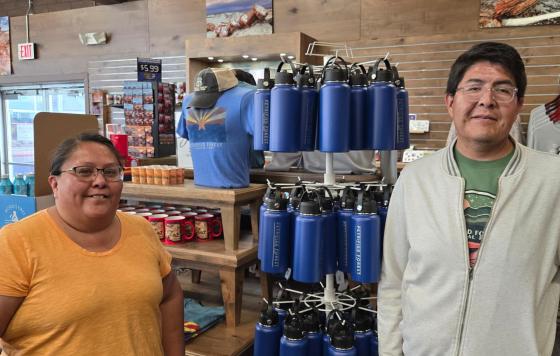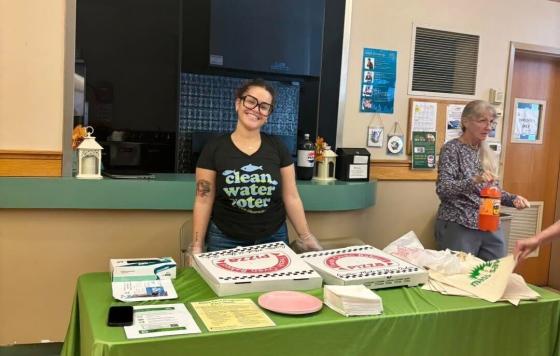
Put yourself in a state of mind to reckon with uncertainty, to hold multiple things simultaneously within your mind at once. To set the stage, let’s visit Rachel Carson’s Under the Sea-Wind, “Against this cosmic background the lifespan of a particular plant or animal appears, not as a drama complete in itself, but only as a brief interlude in a panorama of endless change” (Carson, 1941). We are small, in the impossible grand scheme of things. We are here, then gone, in the blink of an eye, our little blue world so strange. This all matters because we decide it does. Howl like the sea wind because you can, because you are so alive.
Step back now and examine our subject: Rachel Carson. A salt-water woman, born to study marine biology and paint its intricacies in stirring prose. Carson lived a complicated life, glimpsed by her relationship with one Dorothy Freeman. The two shared each summer from the day they met, and between them wrote more than 900 letters. In one letter, Dorothy Freeman wrote, “I love you beyond expression...My love is boundless as the Sea.” In another, Carson wrote, “Reality can so easily fall short of hopes and expectations, especially where they have been high. My dear one, there is not a single thing about you that I would change if I could!” Carson and Freeman destroyed many of their letters shortly before Carson’s death in 1964.
The struggles of the queer experience are transcendental. Back through the pages, queer folks recognize their grief, their joy, their longing, and their wonder in the shape of another person. In her last letter to Dorothy Freeman before her death at 56, Rachel Carson wrote, “Never forget, dear one, how deeply I have loved you all these years.”
Here we have to strike a balance between shining a spotlight on a facet of this person often suppressed while not diminishing her as one thing. One unwieldy box. We celebrate Rachel Carson in the fullness of her being and now turn to her work.
For a time, Rachel Carson worked as a federal scientist for the United States Fish and Wildlife Service. In the early 1950s, however, Carson left her position to pursue a career as a full-time writer. Once Carson had written her often dubbed sea trilogy, Under the Sea Wind (1941), The Sea Around Us (1951), and The Edge of the Sea (1955), she set her sights on a behemoth. Carson created a catalyst beyond her own design that would foster the foundations for modern environmentalism.
It is documented that Rachel Carson did not want to write Silent Spring (1962). Carson’s health was failing in her later years, and taking on such a battle only made her weary. There was a concerted effort from interested entities to prevent Carson from publishing Silent Spring. The use of pesticides like DDT expanded and Carson faced increasing degradation to her reputation. In the end it culminated in Carson’s decision, “There would be no peace for me if I kept silent.” DDT is a lost memory to most of the American populace, so sweeping were the ramifications that Silent Spring sparked.
For her time, Rachel Carson was a radical. Carson advocated for a complete upheaval of science as an institution. She deemed “The ‘control of nature’ a phrase conceived in arrogance…when it was supposed that nature exists for the convenience of man” (Silent Spring, 1962). Much of her work went unrecognized and vilified for most of her life. Only now finding a home in today’s climate action as we reap the rewards of anthropogenic climate change. As the oceans boil, the seas rise, the skies fill with smoke, and the land gives way to drought, fire, and flood.
What Carson failed to recognize in Silent Spring–which reveals the enduring, ignored gap in American environmentalism–is who will bear the greatest burden of pollution and ultimately the beast of climate change. BIPOC, minority, disadvantaged communities experience disproportionate impacts of climate catastrophe and pollution. This is no longer theoretical; this is our lived reality.
As the progenitor of modern environmentalism in the United States, we must reckon with where pillars of history like Rachel Carson fall short. This is not a call to condemn our elders for the random happenstance of birth, the inescapable context of place and time. Rather, to look them in the eye and see them for what they were. People, ordinary and imperfect; riddled with flaws. Not to be glorified or watered down, but to be seen, learned from, and perhaps understood.
Many took Carson’s work through the years and ran with it. Implementing the environmental advocacy she pushed for into anti-racist, Environmental Justice. Finding Queer Ecology in the riot of greenery. Though today’s Environmental Justice centered climate action may not have been within the realm of Carson’s imagination, we can view her work through our own context. We get to decide what tomorrow means.
In Silent Spring, Carson wrote, “In nature nothing exists alone.” We are inextricably linked to our environments and to each other. Those forces that endeavor to isolate and alienate us are the antithesis of human community. Queer joy is found in the recognition of one another, the connection and common good of the collective bound by love. The shout in the darkness that rings, “I am not alone! We are not alone!” It is in the moment that we hear it, and reach out in spite of fear, that we build something unshakeable.
As we walk further forward–each step a year, a decade, a lifetime–the world changes around us. Progress is not linear; backlash is guaranteed by those holding power who perceive change as a threat to the status quo that upholds their privilege. Hold on to the old adage: there is strength in numbers; and the hateful few are outnumbered, drowned out, by us. Look at the greenery around you, open sky above you, and remember: “Those who contemplate the beauty of the earth find reserves of strength that will endure as long as life lasts. There is something infinitely healing in the repeated refrains of nature - the assurance that dawn comes after night, and spring after winter” (Carson, 1962). Look out on the waves and choose tomorrow.
Sources:
www.queerbio.com/wiki/index.php?title=Rachel_Carson
www.butterfly-conservation.org/news-and-blog/lgbtq-history-month-key-players-in-environmentalism
www.environment.yale.edu/news/article/queering-environmental-justice
www.www.nrdc.org/stories/story-silent-spring
www.lgbthistorymonth.com/rachel-carson
www.queerbio.com/wiki/index.php?title=Rachel_Carson


